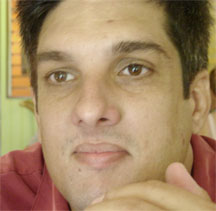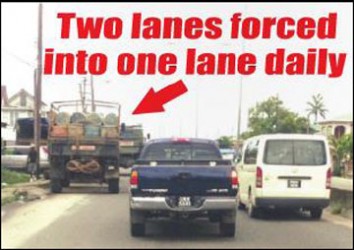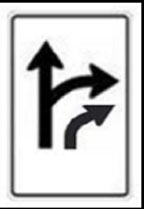(This is the first part in a series of five on the traffic situation. See Part 2 in tomorrow’s edition.)
By Gerhard Ramsaroop
In June, 2011, Stabroek News published an earlier version of my observations on the traffic situation in Guyana. Some improvements have since been undertaken by the authorities, but much remains to be done. These articles are essentially a collaborative effort, with ideas drawn from various sources, including many writers of letters to the editor, members of Parliament and persons on facebook. We are indebted to Daraul Harris for the accompanying artwork.
In this first article we review some of the problems.
Drivers these days rarely follow any of the five Cs (Care, Courtesy, Caution, Consideration and Common sense) that our Police Force once endeavoured to teach us, and the consequence has been chaos and carnage on our roads.
The problems are legion. One is inadequate driver education. Drivers still obtain licences illegally, and because drivers are not trained, accidents result from ignorance of the rules. Do all drivers know that when traffic lights are out of order they must stop and then proceed only if the road is clear? Or that they should dip their bright lights not only for oncoming traffic, but also when driving behind another car?
 While the system of traffic lights has greatly reduced congestion, many drivers still seem unaware of what the lights are indicating. Blinking yellow (amber) means slow down and proceed with caution, while blinking red means stop and proceed if it is clear, and blinking green means yield. There is a difference between blinking green and solid green. Blinking green means slow down as you approach the intersection and if it is clear you may proceed, but you must yield to traffic that has been given a solid green light (for example, at the Mandela and East Bank Highway junction).
While the system of traffic lights has greatly reduced congestion, many drivers still seem unaware of what the lights are indicating. Blinking yellow (amber) means slow down and proceed with caution, while blinking red means stop and proceed if it is clear, and blinking green means yield. There is a difference between blinking green and solid green. Blinking green means slow down as you approach the intersection and if it is clear you may proceed, but you must yield to traffic that has been given a solid green light (for example, at the Mandela and East Bank Highway junction).
Do drivers know that they should signal not only for turning, but for overtaking, changing lanes, merging and pulling over to pick up or drop off a passenger? Do all drivers know that signalling does not give them priority, and that they must still wait until it is clear to turn or merge? Do drivers with provisional licences know they must be accompanied by a licensed driver with at least two years’ experience, and that they may not carry any passengers?
Do drivers know they are only supposed to park on the same side they are driving on? Parking in the wrong direction is not only dangerous as you have to oppose traffic to do so, but it also leads to the inefficient use of scarce parking areas in Georgetown especially. Do drivers know flashing their headlights does not entitle them to drive across the opposing lane without waiting until it is safe to do so?
Do all drivers know that their hands are supposed to be on the steering wheel in the 9 and 3 clock position, and not holding the roof, hanging their hand out the door, having their hand under their chin or any other pose that the driver thinks “cool”? Previously it was the 10 and 2 clock position, but is no longer recommended because it can be dangerous in newer vehicles with smaller steering columns and those equipped with air bags. Do drivers know that defensive driving and being courteous to other road users, including pedestrians and bicyclists, are not options, but governed by rules?
Do all drivers know the purpose of anti-gridlock traffic boxes (for example, at North Rd and Avenue of the Republic)?
To pass a stationary vehicle or avoid a pothole, some drivers simply veer over to the other lane, forcing oncoming traffic to slow down or even stop. This initial wrong move is often compounded by drivers behind the first offender boring through, expecting the vehicles in front to keep traffic clear for them (lines of overtaking vehicles – mini-buses especially – are not uncommon).
 Bad driving needs to be dealt with, but the state and design of our roads also contributes to the chaos. The EBD Highway surely ranks among the most poorly designed infrastructural works in Guyana. It has an insufficient shoulder in McDoom, Agricola and Bagotstown resulting in parked vehicles ending up partially in the left lane (see Kaieteur News, front page, 28th July 2013). In consequence, most heavy commercial vehicles opt to lumber along in the right lane throughout instead of using the left lane.
Bad driving needs to be dealt with, but the state and design of our roads also contributes to the chaos. The EBD Highway surely ranks among the most poorly designed infrastructural works in Guyana. It has an insufficient shoulder in McDoom, Agricola and Bagotstown resulting in parked vehicles ending up partially in the left lane (see Kaieteur News, front page, 28th July 2013). In consequence, most heavy commercial vehicles opt to lumber along in the right lane throughout instead of using the left lane.
There are no storage lanes to facilitate safe turning and merging (such as we have on the Rupert Craig (East Coast) Highway, built over forty years ago). Because there are no storage lanes, vehicles wanting to turn have to stop in the right lane until it is clear to do so, causing a pile-up of traffic behind them. Despite this, all too many drivers unthinkingly continue along in the right lane.
Often too when mini-bus drivers are picking up or dropping off passengers along this highway, they drive on the right lane, then stop, blocking traffic in both lanes so they can move over to the shoulder to pick up or drop off a passenger.
The practice of wrongfully using the right lane makes merging after a turn extremely dangerous on this highway as well. Misuse of the right lane is also rampant on the other four-lane highway, the Rupert Craig East Coast Highway. Even though the right lane is to be used when turning off the highway, you are not supposed to use it all the way from Sheriff St to UG, for example.
 At the Houston turn heading north, where despite that the left lane splits into a right turning lane headed to Mandela Ave, some drivers keep going straight into Georgetown from the right lane which at the point has become a strictly right turning lane (see diagram), thereby cutting across the left turning lane! The broken white line (instead of a solid line between the turning lanes) and the lack of signage only add to the confusion there. So the question begs, do drivers know that right lane is only to be used for turning, overtaking or for when the left lane is full?
At the Houston turn heading north, where despite that the left lane splits into a right turning lane headed to Mandela Ave, some drivers keep going straight into Georgetown from the right lane which at the point has become a strictly right turning lane (see diagram), thereby cutting across the left turning lane! The broken white line (instead of a solid line between the turning lanes) and the lack of signage only add to the confusion there. So the question begs, do drivers know that right lane is only to be used for turning, overtaking or for when the left lane is full?
Sadly, in some cases the authorities themselves are at fault. Bad driving in Guyana is compounded by inadequate and uneven law enforcement and the resultant culture of bribe-paying.
There is poor or non-existent road demarcation, limited road signage and street lighting. The authorities do not always deal with stray animals, vehicles parked without lights or malfunctioning traffic lights, for instance. At Church and Vlissengen, both lights blink yellow which is dangerous because neither driver is required to stop, and if an accident occurs it is difficult to ascertain who is at fault.
Road users and authorities alike will have to pull together if we are to curb the carnage on our roads. In our next article we hope to offer some specific solutions.




